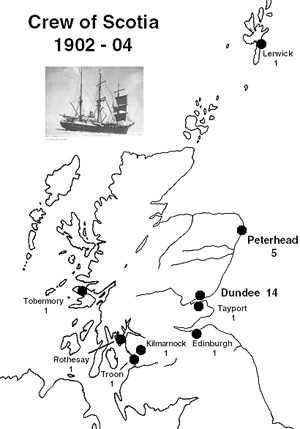
| Glasgow Digital Library | Voyage of the Scotia | BRUCE | PEOPLE | SHIP | ANTARCTIC | INDEX |
|---|
Scotland has played a significant part in Antarctic exploration through her sea captains, sailors and scientists. In the eighteenth century no-one had seen the Antarctic continent and only Captain Cook had crossed the Antarctic Circle.
In the nineteenth century Scottish names began to appear on maps of the Antarctic islands and mainland Antarctica. The Weddell Sea was named in 1822 after the Scottish sealer James Weddell while the other great indentation in the Antarctic, the Ross Sea, was named after James Clarke Ross in 1843. The Ross family came from Wigtownshire.
Between 1872 and 1876 the Challenger expedition was the first major oceanographic expedition in the world. The captain, Sir George Nares, came from Aberdeen. Much of the work on the specimens and information brought home from the Challenger expedition was processed in the Challenger offices in Edinburgh. One of those working on these reports when a student in Edinburgh was William Speirs Bruce.
In 1892 four Scottish whalers from Dundee sailed south looking for right whales. On board the Balaena was the Scottish scientist William Speirs Bruce. Although this was a commercial venture, and despite obstruction by the captain of the Balaena, Bruce managed to collect a lot of meteorological information, descriptions of life in the Antarctic and a few specimens. On his return Bruce was to speak to leading scientists in London about his experiences in the Antarctic. This was one of the stimuli which resulted in the 'Heroic Age of Polar Exploration' (1895-1917).

Exploration of the Antarctic was rather limited until the beginning of the twentieth century. In the period 1901-05 five major European expeditions sailed to different parts of the Antarctic. The ship Discovery, used in the British Antarctic Expedition, was built in Dundee. The captain of the Discovery, the famous explorer Robert Falcon Scott, had Scottish ancestry. Scott's second expedition south was in another Dundee ship, the whaler Terra Nova.
The Scottish National Antarctic Expedition sailed in 1902 on the whaler Scotia. This ship had been rebuilt in Troon, had an entirely Scottish crew, most of the scientists were Scots and the expedition was financed by Scots - mainly by the Paisley thread firm of Coats. William Speirs Bruce was to become one of the greatest explorers of his time, although he never achieved the fame of those attempting to reach the South Pole. This, however, was probably the greatest oceanographic expedition since the Challenger expedition.
Bruce was extremely well known to all of the Antarctic explorers at the beginning of the twentieth century. Many consulted him at the Scottish Oceanographic Laboratory in Edinburgh. Peary - who was the first to reach the North Pole - obtained his furs from Bruce after the Scotia expedition.
Ernest Shackleton was another friend of Bruce. He was secretary of the Royal Scottish Geographical Society after his return from the Discovery Expedition, and arranged the welcome home for the Scottish National Antarctic Expedition. On Shackleton's Nimrod expedition the Scottish doctor Alistair Forbes Mackay was in the party of three who were the first to reach the South Magnetic Pole. Shackleton's Endurance expedition was partly financed by James Caird, the Dundee jute manufacturer. Again some of the crew were from Scotland.
The most famous polar explorer - the Norwegian Roald Amundsen - sailed to the South Pole in the polar ship Fram. This was designed by the Norwegian/Scot Colin Archer. Amundsen met Bruce on several occasions.
Scots have continued to serve in the Antarctic on expeditions and as scientists working for the British Antarctic Survey as worthy successors to the first great Scottish scientist and explorer - William Speirs Bruce.
| Glasgow Digital Library | Voyage of the Scotia | BRUCE | PEOPLE | SHIP | ANTARCTIC | INDEX |
|---|